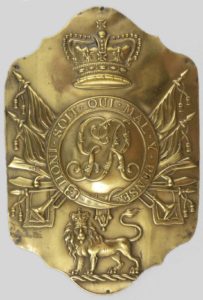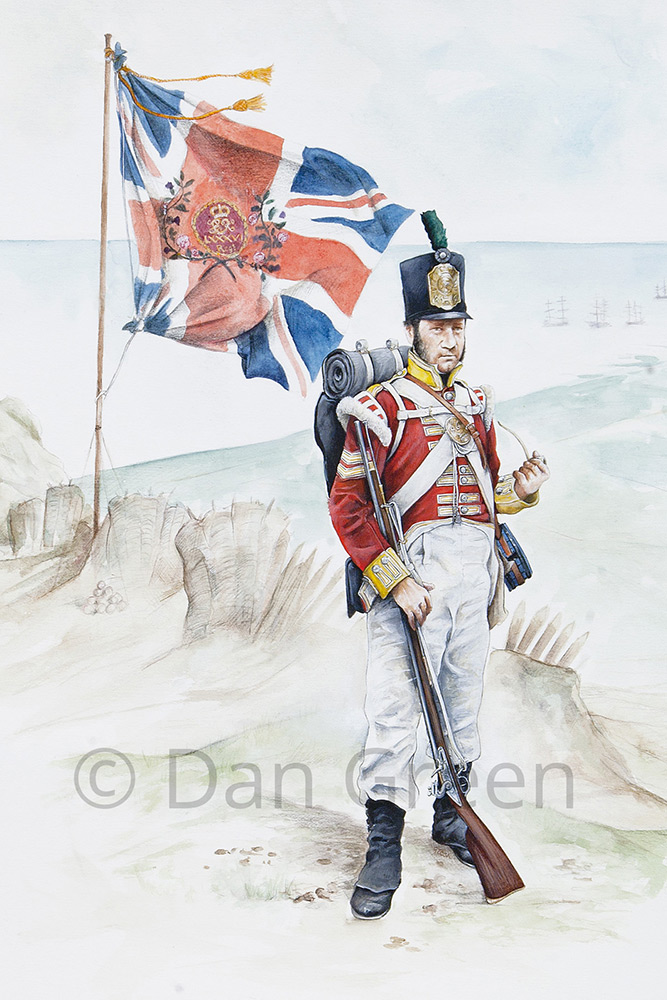William Hall
Corporal, 86th (Leinster) Regiment of Foot
Île Bourbon (Île de la Réunion), 1810



Corporal Willaim Hall
86th ( Leinster) Regiment of Foot
Île Bourbon, 1810
Prints Available – Original Sold
The view is taken from an early 19th century print of the heights overlooking St. Denis on Îsle Bourbon, (or Île de la Réunion as it is now known), the scene of the engagement in 1810, with modifications to make it look like a Redoubt. The water bottle was carried on the left side if armed with muskets to give free access to the cartridge box behind the right hip.
Willaim Hall
Little personal history is known of William Hall, but we do have a record in the Regimental History of the following event where he is named.
“In 1810 occurred one of the major events in our early history. This was the capture of the French island of Bourbon. The island lies well out in the Indian Ocean … There it flanked the trade route, dependent, of course, on the trade winds, followed by British shipping plying to the East. There lurked in its bays and inlets French ships of war and privateers which played havoc with the shipping. The capture of Bourbon, therefore, was vital.
The 86th formed part of the task force which was composed both of troops of the King and those of The Honourable The East India Company. The latter were mostly Indians. The 86th were brigaded with two battalions of sepoys (native Infantrymen), all under command of Colonel Fraser of the 86th …
At 1 p.m. on 7 July 1810 the first landing was effected. This was hotly opposed. Its object was to capture the forts and towns on the coast complete with their garrisons before the latter could escape to wage guerrilla warfare from the cover of the mountainous and wooded centre of the island.
The flank companies of the 86th went ashore, the Light Company leading, the Grenadiers in support. They established a tactical firm base from which they debouched to drive back the enemy’s riflemen and to secure possession of the heights which dominated the beaches. That done, the battalion companies also landed, gained the heights above St. Denis (the capital) and pressed forward to take the enemy’s batteries from the rear, but the surf had become so violent that the other two brigades of the expedition had been unable to land in support. So the 86th had to fall back to the heights where, with their sepoy battalions and gunners, they consolidated for the night.
Early the next morning, 8 July, with the sepoys established as a firm base and protecting the rear, the 86th again advanced, downward from the heights. Their advanced guard was spotted and the Regiment came under very heavy fire from cannon, mortars and musketry. In the face of this they charged, stormed the redoubt which was their objective and closed with the bayonet, driving out the defenders.
The halyards of the flagstaff in the redoubt were shot away but Corporal William Hall (from Rathfriland, Co. Down) climbed the staff under the incessant fire of round shot and musketry. Arrived at the top, he coolly and calmly fixed to it the King’s colour of the 86th. The French soldiers, gallant foes that they were, approved of this daring feat and cheered enthusiastically as the gallant corporal slid down the staff, unhurt. The brisk, successful action of the 86th had also been observed by the seamen of the Fleet offshore. They, too, cheered lustily as the well-known Colour of the Regiment floated proudly from the highest point of the redoubt.
The redoubt was now organised for defence and its captured guns were brought into action by our gunners. The French counter-attack was held and when another brigade of the Force arrived in support the enemy sent in a flag of truce. The island now surrendered to the Force Commander and included in its garrison were found to be quite a few Irishmen, whom the French had recruited from the crews of captured British ships … Corporal Hall was, for his gallant conduct, promoted to sergeant. ‘Bourbon’ was, thereafter, awarded to the 86th as a battle honour.”
William Hall
Little personal history is known of William Hall, but we do have a record in the Regimental History of the following event, where he is named.
“In 1810 occurred one of the major events in our early history. This was the capture of the French island of Bourbon. The island lies well out in the Indian Ocean … There it flanked the trade route, dependent, of course, on the trade winds, followed by British shipping plying to the East. There lurked in its bays and inlets French ships of war and privateers which played havoc with the shipping. The capture of Bourbon, therefore, was vital.
The 86th formed part of the task force which was composed both of troops of the King and those of The Honourable The East India Company. The latter were mostly Indians. The 86th were brigaded with two battalions of sepoys (native Infantrymen), all under command of Colonel Fraser of the 86th …
At 1 p.m. on 7 July 1810 the first landing was effected. This was hotly opposed. Its object was to capture the forts and towns on the coast complete with their garrisons before the latter could escape to wage guerrilla warfare from the cover of the mountainous and wooded centre of the island.
The flank companies of the 86th went ashore, the Light Company leading, the Grenadiers in support. They established a tactical firm base from which they debouched to drive back the enemy’s riflemen and to secure possession of the heights which dominated the beaches. That done, the battalion companies also landed, gained the heights above St. Denis (the capital) and pressed forward to take the enemy’s batteries from the rear, but the surf had become so violent that the other two brigades of the expedition had been unable to land in support. So the 86th had to fall back to the heights where, with their sepoy battalions and gunners, they consolidated for the night.
Early the next morning, 8 July, with the sepoys established as a firm base and protecting the rear, the 86th again advanced, downward from the heights. Their advanced guard was spotted and the Regiment came under very heavy fire from cannon, mortars and musketry. In the face of this they charged, stormed the redoubt which was their objective and closed with the bayonet, driving out the defenders.
The halyards of the flagstaff in the redoubt were shot away but Corporal William Hall (from Rathfriland, Co. Down) climbed the staff under the incessant fire of round shot and musketry. Arrived at the top, he coolly and calmly fixed to it the King’s colour of the 86th. The French soldiers, gallant foes that they were, approved of this daring feat and cheered enthusiastically as the gallant corporal slid down the staff, unhurt. The brisk, successful action of the 86th had also been observed by the seamen of the Fleet offshore. They, too, cheered lustily as the well-known Colour of the Regiment floated proudly from the highest point of the redoubt.
The redoubt was now organised for defence and its captured guns were brought into action by our gunners. The French counter-attack was held and when another brigade of the Force arrived in support the enemy sent in a flag of truce. The island now surrendered to the Force Commander and included in its garrison were found to be quite a few Irishmen, whom the French had recruited from the crews of captured British ships … Corporal Hall was, for his gallant conduct, promoted to sergeant. ‘Bourbon’ was, thereafter, awarded to the 86th as a battle honour.”

